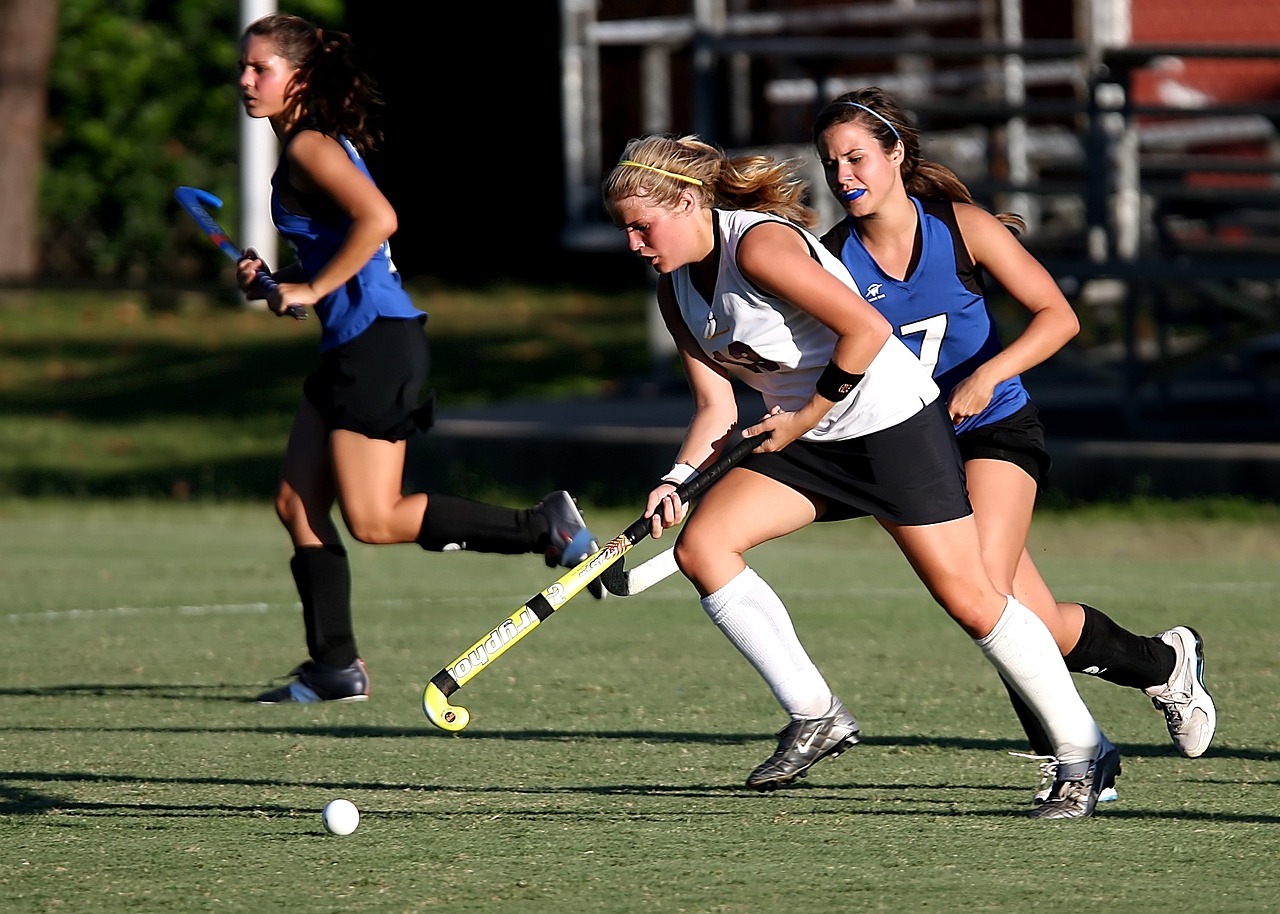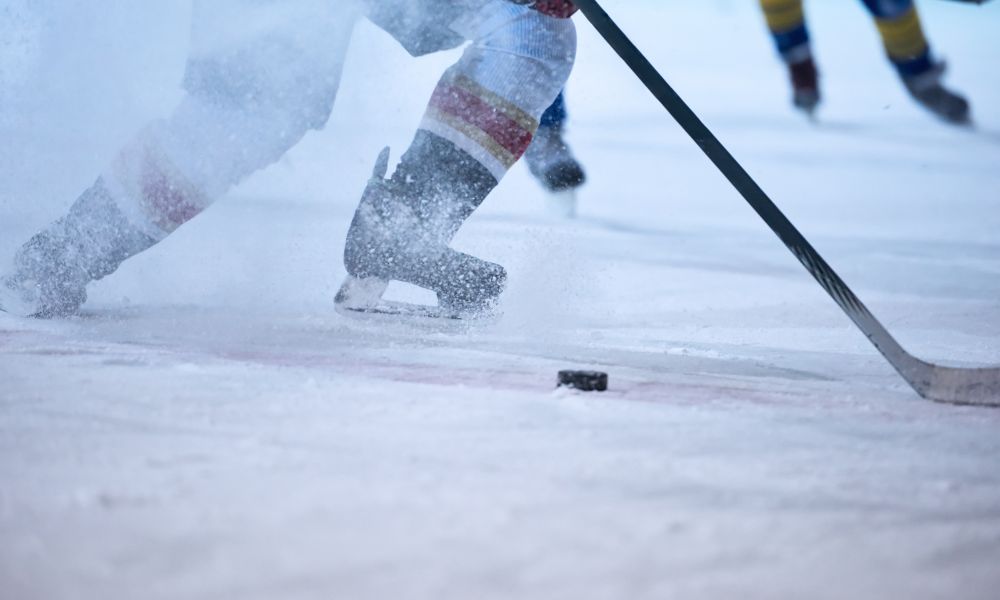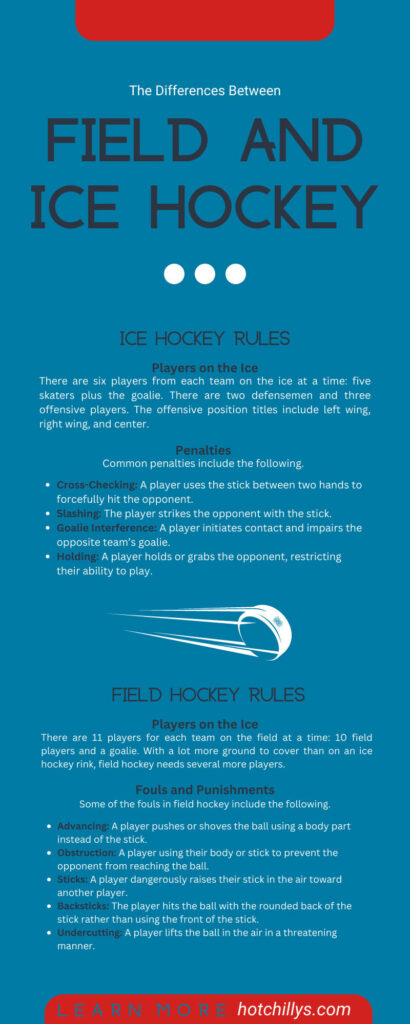Ice hockey is played on ice with skates and a puck, while field hockey is played on grass with a ball. Both sports use sticks but differ in playing surfaces and equipment.
Ice hockey and field hockey are two popular sports with distinct characteristics. Ice hockey is played on an ice rink, requiring players to wear ice skates and use a puck. Field hockey, on the other hand, is played on grass or artificial turf with a ball.
The equipment used also differs significantly, with ice hockey players donning heavy protective gear, while field hockey players wear lighter gear. The pace and style of gameplay vary as well, with ice hockey being faster and more physical. Despite these differences, both sports require skill, teamwork, and strategic play.

Credit: gamerules.com
Introduction To Hockey
Hockey is a fast-paced sport enjoyed by millions worldwide. It comes in two main forms: ice hockey and field hockey. Both versions share some similarities but have key differences that set them apart.
Brief History
Ice hockey originated in Canada during the 19th century. It evolved from stick-and-ball games played on frozen ponds. Early ice hockey matches were chaotic and had few rules.
Field hockey has ancient roots, dating back to the Greeks and Egyptians. The modern form began in England in the 19th century. It quickly spread to British colonies, becoming a popular sport globally.
Popularity Worldwide
Ice hockey is most popular in Canada, the United States, and Northern Europe. The NHL is the premier ice hockey league, drawing fans from around the globe.
Field hockey enjoys massive popularity in countries like India, Pakistan, and Australia. It is an Olympic sport and has a strong following in many regions.
| Aspect | Ice Hockey | Field Hockey |
|---|---|---|
| Origin | Canada | England |
| Playing Surface | Ice Rink | Grass or Turf Field |
| Number of Players | 6 per team | 11 per team |
- Ice hockey is played on ice, with players wearing skates.
- Field hockey is played on grass or turf, with players in shoes.
- Both sports require speed and skill.
- Ice hockey is more physical, with more body contact.
- Field hockey focuses on stick skills and ball control.

Credit: www.morrant.com
Basics Of Ice Hockey
Ice hockey is a fast-paced sport played on an ice rink. The game involves two teams with six players each. The main objective is to score goals by hitting a puck into the opponent’s net using sticks.
Equipment Used
Ice hockey players use a variety of specialized equipment:
- Helmet: Protects the head and face.
- Skates: Allows players to glide on ice.
- Stick: Used to hit the puck.
- Gloves: Protects hands and provides grip.
- Pads: Includes shoulder, elbow, and shin pads for safety.
Playing Surface
The game is played on an ice rink. The rink has specific markings:
| Area | Description |
|---|---|
| Center Ice | The middle area of the rink. |
| Blue Lines | Divides the rink into three zones. |
| Goal Crease | The area in front of each goal. |
The rink is surrounded by boards and glass panels. This keeps the puck and players on the ice.
Ice hockey is a thrilling sport with unique equipment and a special playing surface. Understanding these basics gives you a glimpse into the exciting world of ice hockey.
Basics Of Field Hockey
Field hockey is a popular sport played worldwide. It involves two teams using sticks to hit a ball into the opponent’s goal. Let’s dive into the basics of field hockey.
Equipment Used
Field hockey players need specific gear to play safely and effectively. Here’s a list of the essential equipment:
- Stick: Each player uses a stick to hit the ball. Sticks come in various shapes and sizes.
- Ball: The ball is small, hard, and usually made of plastic. It is about the size of a cricket ball.
- Protective Gear: Players wear shin guards, mouthguards, and sometimes gloves. Goalkeepers wear helmets, chest protectors, and leg guards.
- Footwear: Players wear cleats or turf shoes to provide grip on the field.
Playing Surface
Field hockey is played on different surfaces. Each type of surface affects the game differently:
- Grass: Traditional field hockey was played on natural grass. Grass fields can be uneven and slow the ball down.
- Artificial Turf: Most modern field hockey games are played on synthetic turf. Turf fields provide a smooth, fast surface for the ball.
- Indoor Courts: Some field hockey is played indoors on wooden or synthetic floors. Indoor hockey is faster and has different rules.
Understanding these basics can help new players get started in field hockey. Each element, from equipment to playing surface, plays a crucial role in the game.

Credit: www.hotchillys.com
Key Rules In Ice Hockey
Ice Hockey is a thrilling and fast-paced sport. It has its own unique set of rules. Understanding these rules is essential to enjoying the game. In this section, we will explore the Key Rules in Ice Hockey.
Game Duration
An Ice Hockey game is divided into three periods. Each period lasts 20 minutes. The clock stops for various reasons, like goals or penalties. During stoppages, the game pauses. This makes the actual game time longer than 60 minutes. There are breaks between each period. These breaks last 15 minutes.
Scoring System
Scoring in Ice Hockey is simple yet exciting. Teams try to score goals by hitting the puck into the opponent’s net. Each goal is worth one point. The team with the most goals at the end of the game wins. If the game is tied, overtime is played. Overtime lasts 5 minutes. If no one scores in overtime, a shootout decides the winner.
| Aspect | Details |
|---|---|
| Periods | Three 20-minute periods |
| Scoring | Goals worth one point |
| Overtime | 5 minutes, followed by a shootout |
Understanding the game duration and scoring system is crucial. These elements define the flow and excitement of Ice Hockey. The rules keep the game fair and competitive.
Key Rules In Field Hockey
Field hockey is a dynamic sport with its own unique set of rules. These rules ensure fair play and keep the game exciting. Understanding these rules is crucial for both players and fans.
Game Duration
The duration of a field hockey game is divided into four quarters. Each quarter lasts for 15 minutes, making the total game time 60 minutes. There are breaks between quarters: a two-minute break after the first and third quarters, and a ten-minute halftime break. This structure helps keep the game fast-paced and engaging.
Scoring System
In field hockey, goals can only be scored from within the shooting circle. The ball must be hit or pushed into the goal. A goal is awarded when the ball crosses the goal line between the goalposts and under the crossbar. Each goal is worth one point.
| Aspect | Details |
|---|---|
| Shooting Circle | The area from where goals can be scored |
| Goal Value | Each goal counts as one point |
| Goal Line | The ball must cross this line to score |
Only the flat side of the stick can be used to hit the ball. Players must avoid using their feet, except for the goalkeeper. Fouls result in free hits, penalty corners, or penalty strokes, depending on the severity of the infraction.
- Free Hits: Awarded for minor offenses outside the shooting circle.
- Penalty Corners: Granted for defensive fouls within the shooting circle.
- Penalty Strokes: Given for severe fouls that prevent a sure goal.
These rules keep field hockey fair and enjoyable. Understanding them enhances the experience for everyone involved.
Physical Demands
The physical demands of ice hockey and field hockey are intense. Both sports require high levels of fitness, agility, and strength. Yet, the specific demands vary due to the different playing surfaces and rules.
Player Fitness
In ice hockey, players need strong legs for skating. They must also have upper body strength to handle the stick and puck. Stamina is key, as players skate at high speeds and frequently change direction.
Field hockey players run on grass or turf. This requires excellent cardiovascular fitness. They need agility to dodge opponents and quickly change direction. Strong legs and core muscles help with stability and powerful shots.
Common Injuries
Both sports have unique injury risks. Below is a table showing common injuries in each sport:
| Ice Hockey | Field Hockey |
|---|---|
| Concussions | Ankle Sprains |
| Shoulder Injuries | Knee Injuries |
| Broken Bones | Wrist Fractures |
Ice hockey players often face concussions due to high-speed collisions. They also suffer from shoulder injuries and broken bones from falls and hits.
Field hockey players commonly experience ankle sprains from uneven surfaces. Knee injuries and wrist fractures are also frequent due to the fast-paced nature of the game.
Skills Required
Ice hockey and field hockey demand unique skills from their players. While both sports require strong coordination and agility, the physical demands and techniques differ. This section will delve into the specific skills needed for each sport.
Skating Vs Running
Ice hockey players must master the art of skating. Skating on ice requires balance, speed, and agility. Players need to glide smoothly and change directions quickly. They also need to stop abruptly without losing balance.
Field hockey players, on the other hand, need to run effectively on grass or turf. Running requires endurance, speed, and the ability to sprint. Players must be able to accelerate and decelerate rapidly while maintaining control.
| Skill | Ice Hockey | Field Hockey |
|---|---|---|
| Movement | Skating | Running |
| Surface | Ice | Grass/Turf |
| Speed Control | Gliding | Sprinting |
Stick Handling
Stick handling is vital in both ice hockey and field hockey. Yet, the techniques vary greatly due to the playing surfaces and equipment.
In ice hockey, players use shorter sticks and need to handle the puck efficiently. The puck slides on ice, making it crucial to have excellent control and precision. Players often use both hands on the stick to guide the puck.
In field hockey, players use longer sticks to maneuver a ball on grass or turf. The ball rolls, requiring players to adjust their stick handling techniques accordingly. One-handed dribbling and quick stick movements are essential skills.
- Ice Hockey Stick Handling:
- Shorter sticks
- Handling a puck
- Two-handed control
- Field Hockey Stick Handling:
- Longer sticks
- Handling a ball
- One-handed dribbling
Cultural Impact
The cultural impact of sports varies across regions. Ice hockey and field hockey are no exceptions. Each has carved a unique niche in different parts of the world. Understanding the cultural impact of these sports can provide insight into their popularity and significance.
Fan Base
Ice hockey enjoys immense popularity in countries with cold climates. It is a major sport in Canada, Russia, and the northern United States. These regions boast passionate and loyal fans.
Field hockey, on the other hand, is more popular in warmer climates. It is a major sport in India, Pakistan, the Netherlands, and Australia. These countries have a rich history and a large following.
| Ice Hockey | Field Hockey |
|---|---|
| Popular in cold climates | Popular in warmer climates |
| Canada, Russia, Northern USA | India, Pakistan, Netherlands, Australia |
| Passionate and loyal fans | Rich history and large following |
Major Tournaments
Ice hockey has several high-profile tournaments that attract global attention.
- NHL Stanley Cup
- Winter Olympics
- IIHF World Championship
Field hockey also has its share of prestigious tournaments.
- FIH Hockey World Cup
- Summer Olympics
- Commonwealth Games
These tournaments are celebrated events that draw large audiences. They contribute significantly to the sports’ cultural impact.
Frequently Asked Questions
What Is Ice Hockey?
Ice hockey is a fast-paced sport played on ice. It involves two teams of six players each. The objective is to score goals by hitting a puck into the opponent’s net using sticks.
What Is Field Hockey?
Field hockey is played on grass or artificial turf. It involves two teams of eleven players each. The aim is to score goals by hitting a ball into the opponent’s net with curved sticks.
How Do Ice Hockey And Field Hockey Differ?
Ice hockey is played on ice with a puck, while field hockey is played on grass or turf with a ball. Ice hockey has six players per team; field hockey has eleven.
What Equipment Is Used In Ice Hockey?
Ice hockey players use skates, sticks, helmets, pads, and a puck. Protective gear is crucial due to the sport’s physical nature.
Conclusion
Understanding the differences between ice hockey and field hockey helps appreciate each sport’s unique appeal. While ice hockey requires skating skills, field hockey focuses on running and agility. Both sports offer thrilling experiences and foster teamwork. Whether on ice or grass, hockey enthusiasts can enjoy a dynamic and competitive game.

